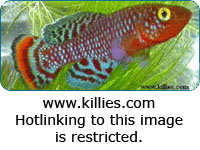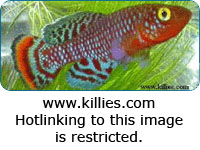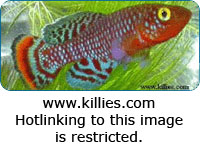|
Peat moss is the most common medium used to incubate killifish eggs. The incubation time varies with different species but it should be quite safe to assume that eggs of the Nothobranchius will hatch in 6 to 8 weeks when kept at 29 degrees Centigrade. The peat should always be stored in a dark and cool place. A styrofoam box is best because it will keep the temperature constant. But it's also okay to keep the eggs inside a bedroom drawer. Eyed-up eggs are a sure indication that the eggs are fully developed. When you are ready to hatch the eggs, do not separate them from the peat when you wet them. For reasons which are not fully understood, the eggs won't hatch without the peat.
|
|
|
When "eyes" appear in the eggs, it would mean it's "wetting time". But even if you cannot spot the eyes, it's okay to wet the peat if you think the eggs are fully developed. No
harm will come to undeveloped eggs subjected to repeated wetting so
long as you dry and bag the peat again. |
|
|
To wet the peat, fill up a plastic tray (20 cm X 20 cm) with aged water to a depth of about 5 cm. I usually use water from an established fish tank. Plastic trays of different sizes are available in Singapore from sundry shops. Pour the peat into the "hatching tray" and gently break up the lumps. When the peat has settled to the bottom, scoop away the floating debris. It's important to keep the surface of the water clear or else it will be very difficult to spot and catch the fry when they hatch. But be careful when removing the floating debris. Although eggs should sink, some may be attached to the floating peat. |
|
 |
If the timing is right, you should see fry within a few hours. If not, wait at least 2 days. The fry won't be able to swim very well when they are newly hatched. For a few hours, they will be just lying on top of the peat, making wriggling movements.
|
| Do not catch them immediately but wait a few hours for them to become "free-swimming" before transferring them into a "raising tray". This is where the fish will be raised until they are about 3 weeks old. | |
|
|
The best tool for transferring fry is a turkey baster. But don't try to look for a turkey baster in Singapore. As far as I know, there are none available. The 3 basters I own came to me from the US of A. Eyedroppers, sold in pharmacies, can be used for catching fry too. The only drawback with an eyedropper is that you will have a lot more *fun* chasing the fry around. If you are planning on buying a turkey baster from an online store, I would recommend you get the one with the angled tip. Be very gentle when transferring fry. Rough handling can lead to broken backs and dead fish. It is not a good idea to use a net to transfer fry as the fish may suffer shock and trauma when removed from water.
|
|
Be sure to have some Java or Christmas moss in the "raising tray". Moss encourages the growth of infusoria and also serves as a "security blanket" for the fry. I usually have my "raising trays" ready a few days before I wet the eggs. To promote infusoria, I put a drop or 2 of liquidfry into the water. It's also useful to have some snails in the tray as their droppings are food for infusoria. Do not put too many fry into one tray or else the mortality rate will be high. I usually will not have more than 20 fry in a 20 cm by 20 cm raising tray. Two days after wetting, dry the peat and bag it. Chances are very good that there will be more fry when you wet the peat again in another 2 weeks. Some eggs, by nature, will not hatch during the first wetting or even the 2nd and 3rd wetting. It's known as diapause, mother nature's back- up system to ensure that in the event of a false or freak shower, not all the fish will be wiped out when the pond dries up again. It's always a good idea to mark down the species and the hatching date on the raising tray, more so if you are raising more than one species of killie. |
|

